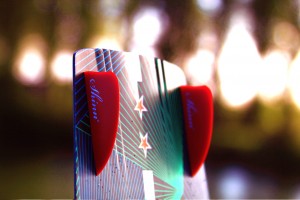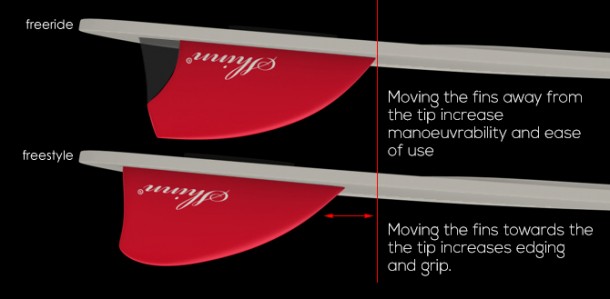For 2014 we’re starting a new series of blog posts featuring kite designers and board shapers behind some of the most successful brands. Our aim is to explain some of the key design decisions that shape the way we kite today and developments that are moving the sport of kitesurfing forward.
Each post will try to answer a single question, with in-depth technical answers, tackled by the guys and girls who spend all their time sweating the details. Hopefully these will be relatively unbiased and free from marketing sway but this will just be the start of the discussion and we hope those interested will get involved, posing further questions and points of view.
This week our second guest post is from Mark Shinn, former world champ and owner/designer of Shinn kiteboards.
Q: Does Fin Placement Make a Big Difference To The Ride Of The Board?
The exact purpose of fins in a twin tip is the source of some debate and confusion, yet few would argue that these are a fundamental part of the board.
Extensive testing of foils, materials, shapes, positions and sizes has led me to a firm believe that the hydro-dynamic benefits are few and far between and that fins fine tune the feel of your ride rather than dictate the way that it feels. If you want to read how I have come to this conclusion you’ll need to read the 2nd part to this piece on fin shape and sizes (coming soon) .
 The exact placement of the fin in the board should be calculated in relation to both the entry point (the start of the leading edge) and the point of maximum depth, of the fin. For each size of board the fin position needs to be adjusted to account for the proportional difference in the length of the fin compared to the board. It’s not however quite as simple as that as the design of the fin itself can lead to a necessity to change the fin position.
The exact placement of the fin in the board should be calculated in relation to both the entry point (the start of the leading edge) and the point of maximum depth, of the fin. For each size of board the fin position needs to be adjusted to account for the proportional difference in the length of the fin compared to the board. It’s not however quite as simple as that as the design of the fin itself can lead to a necessity to change the fin position.
The basic rules of thumb of fin positioning
- Placing the fins as close as possible to the 4 corners of the board will produce the highest amount of grip, this might be appropriate in a freestyle board where turning is of a lesser priority than edging.
- Bringing the fins closer to your feet will improve the turning ability of the board, this may be more appropriate in freeride or wave orientated board where carving is more important than edge grip.
There are however a few things that need to be kept in mind. Fin design can change, a great deal, the handling of the board and if the fin is placed too close to either the rail or tail of the board it may overhang. This is not only a safety issue for the rider but has the tendency to suck air down around it and cause a loss of grip.
Placing the fins to close to the riders foot means the rider has too much leverage over them and can cause the board to lack straight line and upwind performance. In longer boards having the fin too far behind your foot can cause a large increase in foot pressure and cause back leg burn during longer riding sessions.
In general it’s probably best to let the board designer decide on the exact positioning of the fins in the board, however experimenting with different shapes and sizes can make a marked difference in feel and performance (more on this in Mark’s second part to this post). Try testing your board with as many different fins as you can to see what best suits your style and riding ability.
Thanks Mark & Shinn Kiteboards for clearing that up for us. Watch out Mark’s second part on fin shape and size, coming up shortly.
Have you played around with your fin position to see what effect on your board? Let us know your thoughts…
Also check out the first of our Tech Series blog post – Why do twintip boards have full wood cores?


